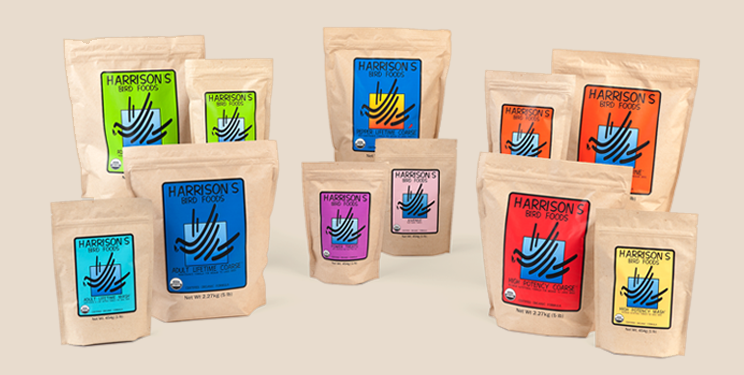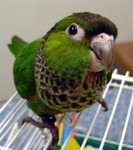|
Nutrition – General Recommendation:

It is important to provide the best possible nutrition for your particular species of bird to allow for a healthy immune system and prevent the stress of vitamin and nutrient deficiency. Realize that all birds are not the same and cannot eat the same diet. Ideally, I like to offer a variety of foods that include a organic and color free avian pellet, a large variety of fresh veggies, and a small percent of fresh fruits and seeds. The following are a few dietary generalization on some individual species, but again it is important that you speak with your veterinarian and do research on your bird prior to making any changes.
In general you need to provide a large variety of fresh food for your bird. Typically I recommend a core diet of an organic and color free parrot pellet. A large variety of fresh vegetables should be provided for both nutrition and mental stimulation. A small amount of seeds can be provided as a treat. Seeds should be clean and fresh. Sprouted seeds can also be offered and are a good way of introducing greens to the stubborn eater.
- Macaws: Variety will occur with the individual types of macaws. However, in general these birds require a higher fat content in their diet which can be provided with some of the large nuts as a part of their regular diet.
- African Greys: Greys are often subject to calcium deficiency and will require higher calcium content in their diet then other birds. The best way to provide this is by providing calcium rich foods such as cheeses and yogurt in moderation. Greens such as collards, kale, and mustard greens provide a healthy source of calcium. Another source is from almonds and dairy products in moderation.
- Eclectus: Ares often require more vitamin A in their diet than other birds, but you must be very careful with supplements because it is easy to create Vitamin A toxicity. Again, providing natural sources of Vitamin A is best. Feed dark leafy green and yellow veggies daily. Sweet potatoes, squash and bell peppers are a good source of Vitamin A that many birds enjoy.
- Small Birds: Budgies & Cockatiels: These guys are my exception to the rule of pellets. In general I like to place my avian patients on a complete balanced pellet, but for budgies and cockatiels I recommend that the pellets be no more than 50% of their diet with fresh/clean seeds offered daily and of course fresh veggies.
Foods to Feed Only in Moderation:
- Those veggies containing a high amount of oxalates. Some common examples include: spinach, chard, and bok choy.
- Fruits, which can provide too much sugar in the bird’s diet.
- Diets that are based 100% on cooked beans/grains/pasta. These diets often have too much phosphorus and are very high in calories which can result in an obese bird.
- The diet should not be based on seeds. Seed diets contain too much fat and are deficient in many nutrients.
Foods to NEVER Feed:
- Caffeine
- Chocolate
- The pits of most fruits – i.e. Avocado
- High acid foods such as tomatoes and pineapple (uncooked)
Converting Your Bird to A Pellet Diet:

Birds learn what to eat from their parent when they are very young. They are true mimic eaters learning what to eat in the wild by watching their parents and other flock members. This can result in some problem for us if the birds were not exposed to a variety of foods by the person rearing the chick. Many birds can be very stubborn about accepting a change in their diet and will actually starve to death because they don’t seem to realize that the new food is eatable. Therefore, any change in diet must be done with close supervision and monitoring or the bird’s weight.
1)Limit seeds to 2 timed meals daily: I like this method because if the owner is persistent it seems to always work. The idea is to take out all seeds and place fresh pellets in their normal food bowl. It is best to leave the pellets in for the first 1-2 hours every morning and then offer 15 minutes of their regular former diet so that they do not go hungry. Repeat this in the evening. The idea is to offer the pellets when the bird are most hungry but to starve the bird into eating
2) Choose a human grade bird pellet such as Harrison’s and allow the bird to see you eating the pellets. Birds learn by example and are likely to be interested in anything you show interest in. Do remember that birds and humans have different normal bacteria in their GI tracts do not offer food from your mouth.
3) Soak the pellets in sweetened juice or a favorite food to encourage eating based on flavor.
4) Make cornbread mix and place the old diet, veggies, and the new diet in the mix. Then feed birdie bread. Harrison’s now makes a powdered starter for birdie bread that I highly recommend.
5) Use a teacher bird. Similar to #2 this allows your bird to learn by example.
6) Feed chop with pellets mixed in: A variety of cooked fresh grains and chopped veggies offered as a warm dish
More Recommendations:
Learn To Each Chop by Parrot Problem Solving LINK
Bird Breakfast Muffins by Parrot Problem Solving LINK
Foraging Cups by Parrot Problem Solving LINK
|